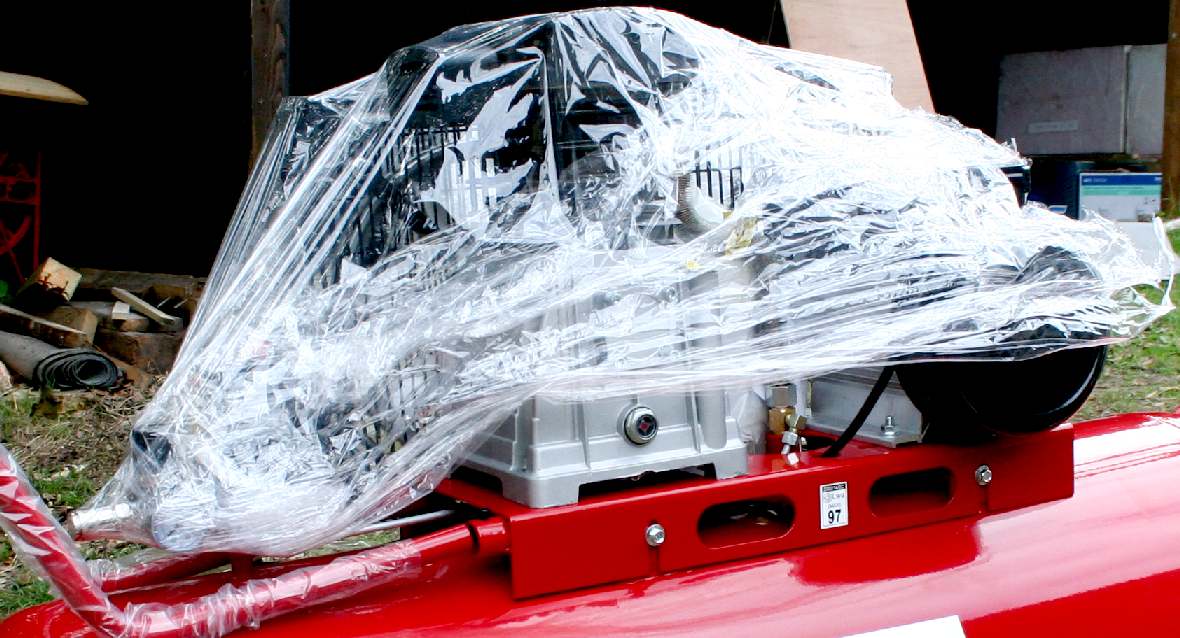|
AMPHIBIOUS LAUNCH - AMPHIMAX - CAB - CHASSIS - CRANE - DIESELS - FLOATATION - GENERATORS - HYDRAULICS - LAUNCH SITE - MODEL 1/20 - TIMETABLE - TRACKS - TRAILER - THRUSTERS - WHEELS
|
|
|
MATJACK - This lifting tube from the US is capable of lifting 10,000 pounds (4.46 tons). It is 210 inches x 66 inches in size and weighs 104 pounds. The cubic capacity is 158 feet. Sixteen of these bags will give us positive buoyancy for the AmphiMax™ where the all up weight is estimated to be around 64 tons. The total mass of the AmphiMax depends on the weight of the tracked bogies - a major consideration where there are eight of these.
We first thought of welding plates to the frame of AmphiMax™ to be able to submerge the vehicle by flooding these compartments, but this would have added to the cost of construction significantly. For this reason we have opted to look at using inflatable tubes that are fitted inside the chassis of our amphibious giant. We could have used large diameter steel tubing as a pressure vessel, but this also proved to be outrageously expensive to source and of course steel rusts, so it did not seem like a good idea if AmphiMax vehicles are to sit around for long periods either surfaced or submerged.
Where the AmphiMax frame is now to be a tubular (RHS) galvanized (or epoxy coated) structure, there is plenty of space to slide inflatable bags inside that are impervious to seawater. All we need worry about then, is how to supply these bags with low pressure air from a high pressure storage system.
COMMERCIAL LIFTING BAGS
Salvage Tubes are highly versatile in the number of ways in which they can be deployed. They are excellent for pipe-laying and other underwater construction projects, but where Salvage Tubes really come into their own is when they are used in raising sunken boats. They can be used vertically to bring the boat out of deep water. When the boat is suspended near the surface they can be slung under the boat with one end on each side to raise the boat high enough out of the water to pump out. In shallow water, two bags can be slung together, one on each side of the boat, like pontoons.
AIR SUPPLY - This twin cylinder compressor has an aluminium head with cast iron bores to give added resistance to wear. The 2.2KW/3HP electric motor drives the compressor via a belt and 280mm flywheel at 920 rpm. The air displacement is 12.6CFM/356L/Min at an operating pressure of 10bar-145psi. The picture on the left is us unwrapping the machine on delivery. From a standing start it would take one machine 3.34 hours to inflate sixteen air lift bags. Two compressors reduces this to 1.68 hours (100 minutes). The 150 liter tanks supplied with these units holds 21,750 cubic feet of air at sea level. This is sufficient to inflate the 16 buoyancy bags several times over at a submerged depth of 15 feet.
In the mid 1600's, Robert Boyle studied the relationship between the pressure p and the volume V of a confined gas held at a constant temperature. Boyle observed that the product of the pressure and volume are observed to be nearly constant. The product of pressure and volume is exactly a constant for an ideal gas:
p * V = constant
Boyle's law is a gas law that helps us to understand compressed air, stating that the pressure and volume of a gas have an inverse relationship, when temperature is held constant. If volume increases, then pressure decreases and vice versa, when temperature is held constant. Therefore, when the volume is halved, the pressure is doubled; and if the volume is doubled, the pressure is halved.
COMPRESSORS
An air compressor is a device that converts power (using an electric motor, diesel or gasoline engine, etc.) into potential energy stored in pressurized air (i.e., compressed air). Positive-displacement compressors are the most common and include the models used for home workshops, woodworkers and mechanics. Here, air pressure is increased by reducing the size of the space that contains the air. Most of the compressors you'll run across do this job with a reciprocating piston.
APPLICATIONS
Air compressors have many uses, including: supplying high-pressure clean air to fill gas cylinders, supplying moderate-pressure clean air to a submerged surface supplied diver, supplying moderate-pressure clean air for driving some office and school building pneumatic HVAC control system valves, supplying a large amount of moderate-pressure air to power pneumatic tools, such as jackhammers, for filling tires, and to produce large volumes of moderate-pressure air for large-scale industrial processes (such as oxidation for petroleum coking or cement plant bag house purge systems).
Youtube
LINKS & REFERENCE
https://en.wikipedia.org/wiki/Boyle%27s_law https://en.wikipedia.org/wiki/Air_compressor
MatJack / Indianapolis Industrial Products, Inc.
RMS Manufacturing Technology Limited
AMPHIBIOUS LAUNCH - AMPHIMAX - CAB - CHASSIS - CRANE - DIESELS - FLOATATION - GENERATORS - HYDRAULICS - LAUNCH SITE - MODEL 1/20 - TIMETABLE - TRACKS - TRAILER - THRUSTERS - WHEELS
|
|
|
This page is Copyright © 2016 Bluebird Marine Systems Ltd. The names AmphiMax™, Bluebird™, Bluefish™, RiverVax™, SeaNet™, SeaVax™ are trademarks. All other trademarks are hereby acknowledged.
|


